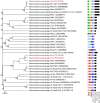Isolation and characterization of novel bacteriophages targeting Stenotrophomonas maltophilia
- PMID: 40804103
- PMCID: PMC12350841
- DOI: 10.1038/s41598-025-14811-5
Isolation and characterization of novel bacteriophages targeting Stenotrophomonas maltophilia
Abstract
Stenotrophomonas maltophilia is a bacterium often resistant to antibiotics and is a significant cause of nosocomial infections, particularly in immunocompromised patients. Phage therapy has shown promise as a potential treatment for such difficult-to-treat bacterial infections, but research on phages targeting this bacterium is very limited. In this study, we isolated 34 phages using four clinical strains of S. maltophilia and evaluated their infectivity and bactericidal activity. While some phages infected all four strains, many exhibited strain-specific infectivity. We investigated the bacterial growth curves in response to three phages, named Yut1, Yut2, and Yut4, and found that all phages exhibited potent lytic activity against the clinical strains even at low doses. Genome analysis found that the phages did not carry any lysogeny genes, virulence factors, or antibiotic resistance genes, suggesting their high potential as therapeutic phages. Furthermore, phylogenetic analysis suggested that Yut1 and Yut4 belong to a novel phage lineage. These results highlight the therapeutic potential of our novel phages to combat the growing antibiotic resistance problem.
© 2025. The Author(s).
Conflict of interest statement
Declarations. Competing interests: The authors declare no competing interests.
Figures





Similar articles
-
Isolation and characterization of bacteriophages with lytic activity against multidrug-resistant non-typhoidal Salmonella from Nairobi City county, Kenya.BMC Infect Dis. 2025 Jul 24;25(1):940. doi: 10.1186/s12879-025-11325-3. BMC Infect Dis. 2025. PMID: 40707891 Free PMC article.
-
Isolation and characterization of phages ΦZC2 and ΦZC3 against carbapenem-resistant Acinetobacter baumannii, and efficacy of ΦZC3 on A549 cells.Virol J. 2025 Jul 30;22(1):262. doi: 10.1186/s12985-025-02885-6. Virol J. 2025. PMID: 40739242 Free PMC article.
-
Characterization and antimicrobial activity of a novel lytic phage vB_SmaS_QH16 against Stenotrophomonas maltophilia: in vitro, in vivo, and biofilm studies.Front Cell Infect Microbiol. 2025 Jul 10;15:1610857. doi: 10.3389/fcimb.2025.1610857. eCollection 2025. Front Cell Infect Microbiol. 2025. PMID: 40708751 Free PMC article.
-
Systemic pharmacological treatments for chronic plaque psoriasis: a network meta-analysis.Cochrane Database Syst Rev. 2017 Dec 22;12(12):CD011535. doi: 10.1002/14651858.CD011535.pub2. Cochrane Database Syst Rev. 2017. Update in: Cochrane Database Syst Rev. 2020 Jan 9;1:CD011535. doi: 10.1002/14651858.CD011535.pub3. PMID: 29271481 Free PMC article. Updated.
-
Systemic pharmacological treatments for chronic plaque psoriasis: a network meta-analysis.Cochrane Database Syst Rev. 2020 Jan 9;1(1):CD011535. doi: 10.1002/14651858.CD011535.pub3. Cochrane Database Syst Rev. 2020. Update in: Cochrane Database Syst Rev. 2021 Apr 19;4:CD011535. doi: 10.1002/14651858.CD011535.pub4. PMID: 31917873 Free PMC article. Updated.
References
Grants and funding
LinkOut - more resources
Full Text Sources

